…‘the aptly named ‘white’ paper on northern development is a grab bag of historical deceit, negligence, ignorance and perverse racist gobbledygook fuelled by the cunning ruthless greed of the colonial masters. The next in an Internationally shameful legacy of destruction of our children’s opportunities, destruction of the homelands, appalling housing, horrifying health, third world poverty, world leading language decline, globally unprecedented incarceration rates, all the while pledging to stop the growing indigenous human misery in the lucky county.’ (Indigenous informant. Galiwin’ku- Elcho Island 12.12. 2018)
Dr Bentley James
www.yolngusignlanguage.com.au
Merry Xmas from me, Galiwin’ku and a vision of Northern Development ?
I am so grateful for this wonderful time of the year and wish you peace and prosperity now, here in the lucky country. As a treat, for those of you who might enjoy, an excerpt from my submission to the THE JOINT STANDING COMMITTEE ON NORTHERN AUSTRALIA REGARDING OPPORTUNITIES AND CHALLENGES ASSOCIATED WITH LAND RIGHTS, NATIVE TITLE AND OTHER LAND-RELATED AGREEMENTS FOR THE PURPOSE OF ENGAGING TRADITIONAL OWNERS IN THE ECONOMIC DEVELOPMENT OF NORTHERN AUSTRALIA.
I say ‘The Australian settler state’s neo-liberal political and economic policies promote a hollow ‘democratisation’ of northern resources and ‘trickle down’ economics, a doctrine that has been proven to be false. The benefits of this doctrine go to the rich, while the poor continue to be exploited. All Australians are poorer for the desecration of the lands and seas that have previously been in stewardship of Australia’s indigenous people.
As a resident for thirty years in North East Arnhem Land and much of that time at Galiwin’ku; a ‘prescribed’ community and ‘growth town’; I have been canvasing the opinions of Traditional Owners and managers about their views on northern development. As an ethnographer and linguist living and working in indigenous communities here in the Northern Territory I understand the importance of seeking the views of the Aboriginal people who have lived here, without cessation, for the longest time ever in human history. To engage sincerely and listen to what indigenous people are saying is a critical first step to a clear understanding of context. This makes good sense, especially when the stated goal of the JSCNA standing committee enquiry is to better understand the potential for indigenous engagement in northern development.
I have looked at the ‘White Paper’ and showed it to a number of Galiwin’ku residents. When the traditional owners and their (traditional) managers, understood the position put forward in this white paper they were incensed.
I have chosen one example, this informant’s views are interesting, in large because they are indicative of the general feeling of indigenous people at Galiwin’ku in regard to the white paper, and the present policies and conditions of settler state exploitation in particular. I thought it worth quoting in part, as engagement with indigenous views also includes an opportunity to hear critique of government policy. An unnamed indigenous informant (Galiwin’ku- Elcho Island) declares;
…‘the aptly named ‘white’ paper on northern development is a grab bag of historical deceit, negligence, ignorance and perverse racist gobbledygook fuelled by the cunning ruthless greed of the colonial masters. The next in an Internationally shameful legacy of destruction of our children’s opportunities, destruction of the homelands, appalling housing, horrifying health, third world poverty, world leading language decline, globally unprecedented incarceration rates, all the while pledging to stop the growing indigenous human misery in the lucky county.’ (Indigenous informant. Galiwin’ku- Elcho Island 12.12. 2018)
The naive might ask, why would indigenous people in the ‘growth town’ Galiwin’ku be so unhappy with current Commonwealth and Territory policies. Such views are undoubtedly the outcome of a history of lived experience. The mistrust of the motives and actions of the settler state, corporations, and the cattle and mining industries will not diminish without a national commitment to inclusive and sustainable development across the north. A transformational change is necessary to targeted consultation and good will in the formation of local arrangements that are geographically, historically, culturally and socially valid.
Indispensable is an inclusive, sustainable Northern Development as conceived in the book ‘Sustainable Land Sector Development in Northern Australia: Indigenous rights, aspirations, and cultural responsibilities. J. Russel-Smith, G. James, H. Pederson and Kamaljit K. Sangha 2019
To best understand the opportunities for equitable northern development we must look at what leading scientists, social scientists, historians, residents, and Indigenous experts say and have said about potentials and conditions for indigenous engagement. Three questions structure this discussion.
- Who are the majority stake holders, e.g. those most affected by potential northern development?
- What is the history of northern indigenous policy?
- What is an indigenous view of equitable development policy?
- Who are the majority stake holders, those most affected by northern development?
Indigenous landowners directly own or control 40% of northern Australia in land held under statutory land rights, native title, pastoral lease ownership, Aboriginal reserves and management of national parks. Altogether traditional owner groups across northern Australia have rights to 90% of northern Australia and its coastline, and constitute the major permanent population, giving them an unequalled commitment to inclusive northern development. They must be recognised as ‘equity partners’ in any vision for a northern future.
- What is the history of northern indigenous policy?
I do not here recount the whole dismal and dismaying colonial legacy of domination and exclusion, better Henry Reynolds might approach such a colossa, rather, I want to bring attention to the number of costly ineffectual parliamentary enquiries, royal commissions, judicial hearings and official reviews that have achieved so little for the north’s indigenous population. They forcefully bring into stark relief the rhetoric of the state, the bitter irony of it’s international assertions and its performance. This juxtaposition progresses the state of northern social distrust, dysfunction and debility. For example, numerous Royal Commissions into Aboriginal Deaths in Custody ‘recommend incarceration as a last measure’ But, in complete contradiction to this we have the world’s most appalling indigenous incarceration figures with the NT having 87% of the prison population countrymen. These policies are affecting indigenous lives in ways the committee’s members and associates can barely imagine. All but two of the 97 recommendations of the ‘Little Children are Sacred Report’ have been ignored by successive governments. Indigenous people continue to struggle to provide for their children under the shadow of a second ‘stolen generation’, via child removals by the state. These conditions are not acts of god, accident, bad weather or personal choice, these are the outcomes of deliberate policies of governments and the agencies of government being put into practice. This substantially reinforces an ongoing mistrust of government, its agencies and the corporate proponents they back.
Indigenous people have won the battle over recognition of common law rights, land determinations and statutory acknowledgement but this has not translated into institutional and public policy reforms. It is your opportunity to change this.
What is missing is an essential shift to inclusive social and economic policy frameworks that fully and equitably engage indigenous participation in the nation’s northern future.
The ‘white’ paper does not address these issues and as such is distorted and unrealistic.
- What is an indigenous view of equitable development policy?
There are lectures, papers, on-line resources and books written on the subject. A full bibliography would be excessive, however, considering the need for clarity in this matter I have attached a critical reading list.
In summary then, the land title system of Australia’s north needs to be remodelled. In particular, pastoral lease reforms, to create a fungible land tenure system that does not extinguish native title, taking for an example the ALRA NT 1976, and transfers ownership of crown land to Traditional Owners and their managers, creating a solid foundation for indigenous engagement, and on-going certainty in stewardship, (the mining lobby can afford to and will continue to force and frustrate land use agreements for exogamous profit ). Nevertheless, under a reformed, uniform and equitable land system land can be leased back to industry and government providing certainty about future potential investments, equity for countrymen and dispel the pall of corrosive mistrust. It is universally recognised that in all locations efficient economic outcomes require; as a foundational factor; efficient and effective allocation of property rights. The north suffers from a failure to meet this basic requirement.
A reformed inclusive aboriginal land title ownership system can open up the potential of the north’s extraordinary rangelands to horticulture, biodiversity mining, carbon sequestration, solar energy farming, ranger programs, local fishing cooperatives, eco-tourism and structurally embed future generations of Aboriginal Australians into the social, economic and political institutions of northern Australia for a sustainable and ethical future. And provide real opportunities for people to continue to live on their country in the way they desire.
Aboriginal people want and deserve secure title over their land, only then can we have a foundation upon which we can all prosper and not just the privileged, mining and corporations.
Let’s not forget that ‘democracy’ as an ‘idea and practice’ is still profoundly contested here and internationally, in spite of attempts to naturalise and globalise the pernicious neo-liberal version promoted by free market fundamentalists since the 1980s. I encourage you to be different, disregard the corrosive ‘white paper’ and try inclusive, sustainable Northern Development as conceived in ‘Sustainable Land Sector Development in Northern Australia: Indigenous rights, aspirations, and cultural responsibilities.
Bibliography.
Baymarrwaŋa, L, James, B (2014) Yan-nhaŋu Atlas and Illustrated Dictionary of the Crocodile Islands. pp.7. The Tien-Wah press, Singapore & Sydney Australia.
Dodson M Chairman’s Address NAILSMA (2013) ‘An Indigenous prospectus for participation in the sustainable development of north Australia’, North Australian Indigenous Experts Forum (IEF) on Sustainable Economic Development- Second forum Report Kakadu National Park, Northern Territory, 30 April -2 May 2013 NAILSMA Knowledge Series 019/2013 North Australian Land and Sea Mangers Alliance. Ltd. Darwin. N.T.
Kirmayer LJ, Dandeneau S, Marshall E, Phillips MK, Jenssen Williamson K. ‘Rethinking Resilience from Indigenous Perspectives’. Canadian Journal of Psychiatry 2011; 56(2), 84-91.
Martin DF, Martin BF (2016) ‘Outstations as manifestations of Aboriginal self-determination: Wik strategic engagement and disengagement over the past four decades’ in Peterson N, Myers F (Eds) Experiments in self-determination : histories of the outstation movement in Australia’ ANU press, Canberra. ACT, 201-228.
Morrison J (2012) ‘Towards resilient communities through reliable prosperity’ North Australian Indigenous Experts Forum (IEF)on Sustainable Development- First forum report Mary River Park. Northern Territory 19-21 June NAILSMA Knowledge Series 013/2012 North Australian Land and Sea Mangers Alliance Ltd (NAILSMA). Darwin. N.T.
Morrison J, Managing for the Future: A culture based economy for northern Australia. Symposium presentation, Charles Darwin University, May 11, 2006. Darwin N.T.
North Australian Land and Sea Mangers Alliance(NAILSMA)(2012) ‘Towards resilient communities through reliable prosperity’ North Australian Indigenous Experts Forum on Sustainable Development- First forum report Mary River Park. Northern Territory 19-21 June .pp.10.NAILSMA
Paton, D & Johnston, D (2017) Disaster Resilience: An integrated approach (2nd Ed). Springfield, Ill., Charles C. Thomas.
‘Sustainable Land Sector Development in Northern Australia: Indigenous rights, aspirations, and cultural responsibilities. J. Russel-Smith, G. James, H. Pederson and Kamaljit K. Sangha 2019
Walayjala-jalaburu jayida jarringgun buru Nyamba Yawuru ngan-gamirlimirli: Planning for the future: Yawuru Cultural Management Plan. The cultural management plan for Yawuru coastal country and the Yawuru Conservation Estate 2nd Edition. March (2013) Galiya Edgar J, Chairman, Yawuru Culture and Heritage Sub-committee. pp.80. Broome W. A.
Whitehead PJ, Russell-Smith J, Yates CP (2014) Carbon markets and improved management of fire in north Australian savannas: identifying sites for productive targeting of emissions reductions. The Rangelands Journal 36, 371-388.
Yibarbuk D, Whitehead PJ, Russell-Smith J, Jackson D, Godjuwa C, Fisher A, Cooke P, Choquenot D, Bowman DMJS (2001) Fire ecology and aboriginal land management in central Arnhem Land, northern Australia: a tradition of ecosystem management. Journal of Biogeography 28, 325-344.
Yu, P (2013) Keynote Address: Scoping the New Paradigm for Northern Australian Development. World Indigenous Network conference, Tuesday 28th May 2013 North Australian Land and Sea Mangers Alliance. Ltd (NAILSMA). Darwin. N.T.
Yolŋu Sign Language YSL and the CII

Subscribe to continue reading
Subscribe to get access to the rest of this post and other subscriber-only content.
Discover posters of Indigenous Knowledge of the Crocodile Islands.
A1 sized laminated posters 420 × 594mm
Yan-nhaŋu Fish of the Crocodile Islands, Shellfish of the Crocodile Islands and a poster of Baymarrwanga, More powerful together: Celebrating International Women’s Day 2019. Proceeds go towards our volunteer project to get this work online for school children in North East Arnhem Land. All the best from the YSL team.

50 dollars including postage at https://www.yolngusignlanguage.com.au
Created for schools in North East Arnhem Land these posters give students insight into a different way of knowing our world.
Dedication: For a new generation of people who are walking n the footsteps of the ancestors. This project is part of the Crocodile Islands Initiative to create opportunities to manage and govern the marine resources in a sustainable way consonant with ancestral laws.

YIRRKALA HOMELANDS CELEBRATION.
A great BIG YSL thankyou to the Laynha homelands teachers and Yirrkala Homelands School. Illustrating the living Yolŋu Sign Language of North East Arnhem Land.
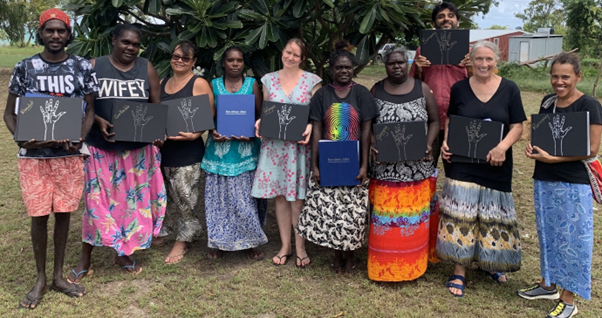
Let’s celebrate the work of the homeland’s teachers of Yirrkala. It is the work of these dedicated people and their homelands communities that are keeping our Indigenous language alive. Yolŋu have always been generous with sharing their sacred knowledge with those who have the proper reverence for it. These are the people who know.
Yolŋu Sign Language (YSL) is a rare, endangered language. It took over 25 years on the homelands and in the communities of North East Arnhem Land to collect these five hundred signs and put them together for the children. This work is driven by the need for passing on this language to a new generation of Yolŋu children, a need to share YSL with all Australians. As each indigenous language disappears all our worlds are diminished. These signs of YSL collected from the east with the rising sun and to its setting in the west of Yolŋu Country, are the visible evidence of the language of the ancestors. This is something to celebrate.
Yolŋu Sign Language (YSL) recorded in this book, belongs the Yolŋu signers and speakers of this rare, endangered language.
The YSL Illustrated Handbook describes ‘HOW TO SIGN YSL’, it explains the grammar, vocabulary, structure and conventions of Yolŋu sign language in an easy-to-use, full-colour guide for everyone. Here we bring together some 500 signs of YSL collected from all across Yolŋu Country.
Baymarrwaŋa would always say“Limalanha gurrku mana maŋutjiguma limalama djäma märr dilak yanama dhuyugu Yolŋulu gurruku mana nhäma marŋgiyirri limalagara. Bilabilagumunu ŋanapuluma nhaŋ’kumunu dhäŋuny bulthuna nhapiyana mananha limalama dilak mittji nyenanha baman’ŋatjili”. We follow the way of the ancestors, the way of those who come before.
Baymarrwaŋa spent a lifetime promoting the intergenerational transmission of local language and knowledge to sustain authentic livelihoods on the homelands. Thanx to the generosity of many and the help of volunteers, we have realised this wonderful project. Get involved, buy a book.
Proceeds go towards our volunteer project to get this work online for school children in North East Arnhem Land. All the best from the YSL team.
Purchase here.
Adam Kendon, Professor of Sign languages at Cambridge says:
‘This is a noble project, and the magnificence of the book well serves to honour the Yolngu, their sign language and their culture… ‘(Kendon 2021: 310)
Furthermore he says, ‘it is very gratifying to see that the study of alternate sign languages is becoming an appropriate object of investigation for sign language linguists….and…this book, has the dimensions, weight and quality of a very fine art monograph or coffee-table book…’ ‘(Kendon 2021: 312)
And an interesting fact for those of you who know Adam, or have lived in Warlpiri country, or just like anecdote, he Prof Adam Kendon, is known by the title ‘rdaka-rdaka’ in the Tanami Desert, literally “hand-hand”, but the hand sign used to signify him was that of a helicopter, also incidentally the sign used to signify a butterfly. Thankyou to the wonderful Frank Baarda of Yuendumu for that little insight. Good luck with your hand signs. B
Bibliography.
Kendon, Adam, 2021 Review Essay on The Illustrated Handbook of Yolŋu Sign Language of North East Arnhem Land by Bentley James, A.C.D. Adone, and E.L. Maypliama (eds). (Australian Book Connection. 2020), Oceania, Vol. 91, Issue 2 (2021): 310–314 DOI:10.1002/ocea.5304,
James, B., A.C.D. Adone, and E.L. Maypliama (eds) 2020.The Illustrated Handbook of Yolŋu Sign Language of North East Arnhem Land, Australian Book Connection. Pp328.
A Good Sign: Visual Languages in Australia
By Rebekah Bradshaw.
In this article by Rebekah she examines the rarely seen world of Bimodal Bilingualism.
In my last article I introduced you to Auslan, the language of the Deaf community in Australia. Whilst Auslan traces its origins to the 19th Century, signing has been a part of many Aboriginal cultures across the continent for millennia – and not just amongst the Deaf or hard-of-hearing members of society. In this second part, we will look at some Aboriginal sign languages and their impressive scope for communication.
Primary vs alternate sign languages
Aboriginal sign languages in Australia are what’s known as “alternate” sign languages. Whilst a primary sign language develops within a Deaf population as their main means of communication, an alternate sign language develops amongst a hearing population for use where speaking is either not practical or not allowed. It is not a signed version of the spoken language, rather its own language with the same expressive capabilities for all circumstances where the spoken language would also be used.
The ability to communicate in both spoken and signed languages is known as “bimodal bilingualism”. A child of Deaf parents would be bimodal bilingual, as would a Deaf person with a cochlear implant who can communicate in both English and Auslan. But bimodal bilingualism existing across an entire, mostly hearing society is a relatively rare phenomenon. Australia seems to be one of the few places on Earth where bimodal bilingualism is common. Linguist and anthropologist Dr Bentley James suggests that it is Aboriginal communities’ strong connections to both their country and kin that traditionally made the practice of bimodal bilingualism so widespread – but, he says, this is also what makes it so vulnerable today.
The significance of alternate sign languages in community
Silent communication through signing has many different uses in Aboriginal communities, both practical and ritual. In a society with such complex law and social structures, an alternate sign language is a useful alternative when speaking out loud is considered taboo. This can include during periods of mourning, visiting a sacred site, or respecting kin avoidance rules. On Yolŋu country in the Northern Territory, no loud noises are permitted around fish traps to prevent the Ancestors from hearing and emptying them. The people use Yolŋu Sign Language (YSL) whenever they are going fishing or even speaking about their intention to fish. Signing can also be used in a variety of everyday situations where it is preferable to speaking, such as communicating discreetly or at a distance, hunting without startling the animals, and even having a conversation in a noisy truck traveling over a bumpy road.
Aboriginal alternate sign languages can also be readily adopted as the primary language of Deaf people in the community, allowing Deaf and hearing members to seamlessly communicate with each other in a way that the Deaf community across wider Australian society does not generally experience. The commonality of signing in these communities means that there is no stigma attached to communicating in this way. As Aboriginal people are ten times more likely to be affected by ear diseases than the rest of the Australian population, many people living in Aboriginal communities today have some form of hearing loss. Alternate sign languages allow these people to participate fully in their society, strengthening their connections to culture and country. Hearing, partially hearing and Deaf Yolŋu people all use YSL in their daily communication.
Expression and meaning in Aboriginal sign languages
As alternate languages, Aboriginal sign languages may exhibit a relationship with the local spoken language, although this connection does vary across communities. Linguist Adam Kendon studying the Warlpiri Sign Language, or Rdaka-rdaka (‘hand signs’), of the Central Desert, reports a tendency in the language for manual representations of spoken Warlpiri morphemes. For example, the Warlpiri word for ‘sun’ is wanta, and the word for a type of red ant is wantawanta. In Rdaka-rdaka, the sign for ‘red ant’ uses a similar hand-shape and movement as the sign for ‘sun’, but repeated in the same way that wanta is repeated to make wantawanta. Yolŋu Sign Language, however, does not seem to exhibit any convergence with a spoken language, being linguistically independent from the language group Yolŋu Matha as well as the many other local languages belonging to the region. This may be because communities on Yolŋu country are highly multilingual – YSL is just another language of many, not particularly linked to any of the others.
We learned that Auslan makes use of many non-manual modes such as facial expression and mouth shape to create meaning, and YSL is similar. Form in YSL consists of four manual components (hand-shape, location, movement and orientation), and one non-manual component (such as facial expression and mouthing). This can be an important way to distinguish between minimal pairs, of which YSL has quite a few – for example, the manual signs for ‘who’ and ‘what’ are the same, only with different mouthing. In Warlpiri Sign Language, however, signs appear to be manual only with no mouthing.
Unlike in a primary sign language like Auslan, “iconic” signs representing visual characteristics of a referent are not common in Aboriginal alternate sign languages. This may be because of how ancient these languages are, or it may also be a result of their cultural connections – a sign may have deep roots in an element of Dreaming lore, rather than be based on what something looks like.
In terms of grammar, Dr James says the grammar of YSL is similar to that of Yolŋu Matha due to the fact that it covers similar communication needs, although he found it to be simpler and easier to learn. In YSL, the verb usually appears first in a phrase or sentence, but word order generally doesn’t matter. Amongst the Warlpriri people, Kendon found that sentences were constructed in more or less the same way whether a storyteller was signing or speaking their narrative.
Preserving a language
Sadly, as the changes brought by colonisation have threatened important connections to country, the wonderful phenomenon of bimodal bilingualism is increasingly vulnerable, and in some places has been lost altogether.
When I first learned about Warlpiri Sign Language, I was intrigued to find out that Deaf Warlpiri people today were usually more likely to develop their own “home sign” systems to communicate with close family. They might also learn Auslan, particularly if they attended school away from their community, or they might use Ailan – Aboriginal and Torres Strait Islander Sign Language, a mixture of Auslan, Signed English, and some local Indigenous signs. Was there a reason that Deaf Warlpiri people picked up other signed languages instead of their own? According to Dr Bentley James, this was not always the case. When he lived on Warlpiri country in the 1980s, the alternate sign language of Rdaka-rdaka was automatically adopted by Deaf people as well as being used widely in the community. Unfortunately since then, modern life and new technologies have brought changes to the community way of life and led to more people living and working away from their country, which has in turn led to a decline in the intergenerational transmission of Rdaka-rdaka. Up in Arnhem Land, the Yolŋu people are currently working hard with Dr James to make sure the same thing does not happen to their alternate language.
An estimated 7,000 people use YSL today, although its continuing use is threatened. ‘The Illustrated Handbook of Yolŋu Sign Language of North East Arnhem Land’ is a project almost 30 years in the making, spearheaded by Crocodile Islands local and 2012 Senior Australian of the Year Baymarrwaŋa. The book contains photos of around 500 Yolŋu signs and the hand-shapes required to produce them – not nearly all of them, but enough to allow learners to develop conversational ability in the language. These selected signs include a number of rare idioms, preserved by the older generations since before colonisation. The signs are also accompanied by a learner’s guide to the language, some example sentences and an index in both English and Yolŋu Matha. Although Baymarrwaŋa passed away before she could see the handbook completed, her work has created a valuable legacy for future generations, with copies of the handbook donated to schools across the region.
Because YSL has such a strong connection to country and culture, Baymarrwaŋa and her team also established a number of other projects alongside the YSL handbook in order to ensure its survival for the next generation. This includes a junior ranger program, the Crocodile Islands Rangers. In carrying out certain tasks on country as rangers, young people are required to know and use signs – for example, when working with fish traps as discussed earlier. Community-led initiatives such as this ensure that YSL remains a living language in every sense of the word.
To make Yolŋu Sign Language even more accessible, Dr James and the community are now working on an online version of the handbook. You can visit https://www.yolngusignlanguage.com.au if you want to learn more about these important projects and how you can support them. You can even buy a copy of the handbook and teach yourself how to sign – the Yolŋu people want to share their incredible language with everyone!
There is so much more to say about the wonderful world of bimodal bilingualism (and sign languages in general), but not enough space in this magazine! Hopefully through this two-part series, I have been able to broaden your linguistic horizons with an appreciation for not only the validity but also the remarkable expressiveness of both primary and alternate signed languages.
Further Reading:
—–2020a. The Illustrated Handbook of Yolŋu Sign Language of North East Arnhem Land 350pp Australian Book Connection. Melbourne. Vic. 328PP
—–2020b Decolonizing Research Methodologies, ” Sign Language Studies. Spring issue of Gallaudet University, Lexington books Rowman and Littlefield. Boston. USA.
Kendon, A, 2021 Review Essay on Illustrated Handbook of Yolŋu Sign Language of North East Arnhem Land by Bentley James, A.C.D. Adone, and E.L. Maypliama (eds). (Australian Book Connection. 2020), Oceania, Vol. 91, Issue 2 (2021): 310–314 DOI:10.1002/ocea.5304,
—–. 2015. Some characteristics of Australian Aboriginal sign languages with hints for further questions for exploration. Learning Communities: International Journal of Learning in Social Contexts [Special Issue: Indigenous Sign Languages], 16, 6-13.
Power, D. 2013. Australian aboriginal deaf people and Aboriginal sign language. Sign Language Studies, 13(2), 264-277.
https://pursuit.unimelb.edu.au/articles/speaking-my-language-indigenous-deaf-sign
BUY A STAKE IN THE FUTURE: INVEST IN INDIGENOUS LANGUAGES TODAY
I cant stand by and watch Indigenous languages perish because of indifference and the perversity of policy.
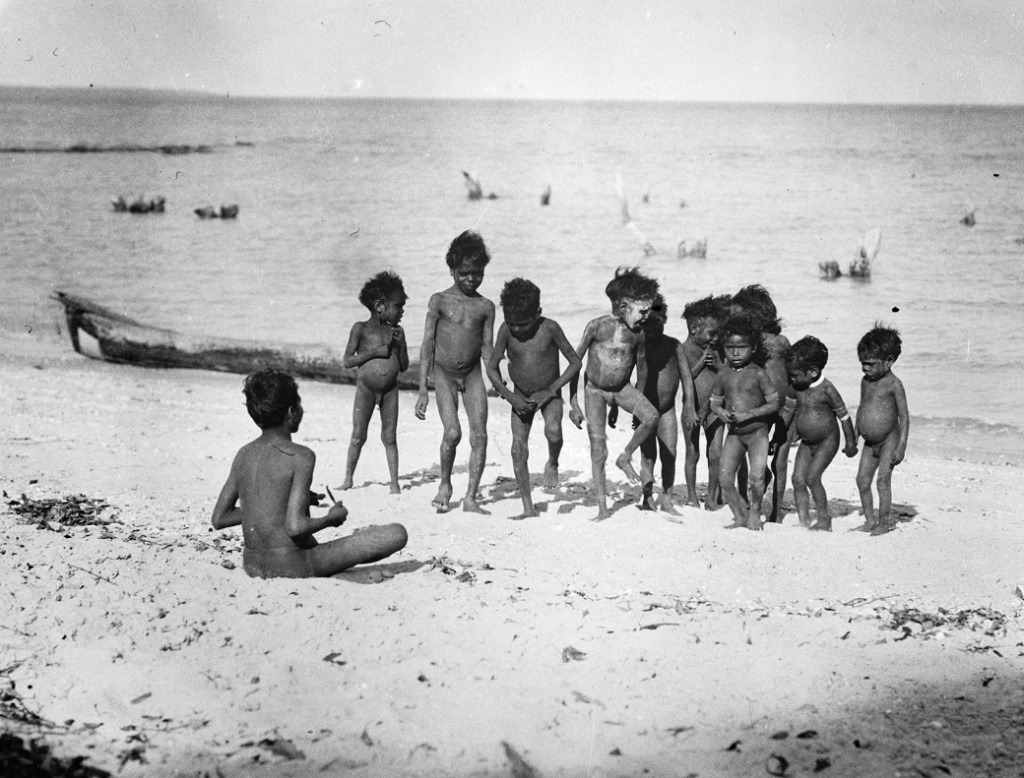
Australian and International research in linguistics, cognitive psychology and education convincingly demonstrate that the strength and confidence necessary for Indigenous first language learners to achieve in mainstream education rests squarely on cultural competence in the first language (Cole, M. (1975); Lyster, R.; Mori, H. (2006). This affirmation of the necessity of bilingual, bicultural and bimodal education – supporting the unyielding claims of Indigenous people themselves, is based on overwhelming evidence.
The key problem is the Australian government, their perverse corporate masters, and their education policy. The Commonwealth, and especially the Northern Territory government, continue to deny N.T Indigenous people, and more widely across the north of Australia, adequate and easy access to languages and homelands support and funding. (Quietly “empty” the homelands, ‘closing the gap’, ‘assimilation’- extinction, [for]- frack, and gas, and cattle and mine)
Let me be the first to do something. Got to keep the dream machine turned on. In an unprecedented move to fund our YSL online project for kids in school, I will offer my private copies of the Yan-nhaŋu Atlas and Illustrated Dictionary of the Crocodile Islands and the magnificent Maypal, Mayali’ ga Wäŋa, available for purchase. In exchange for money, I will give the Atlas, or Maypal, to those who would like to own one. There are only a few left so, be quick.
Details at https://www.yolngusignlanguage.com.au/
YSL HANDBOOK
The Illustrated Handbook of Yolŋu Sign Language of North East Arnhem Land Project
CLICK HOME TO FIND OUT MORE;
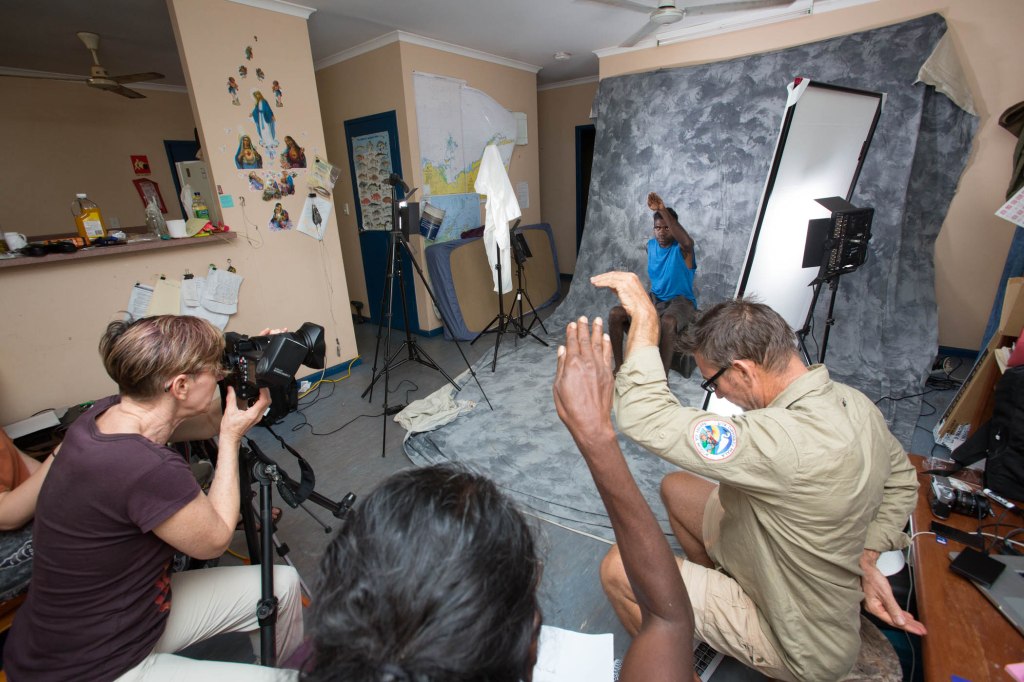
Therese Ritchie shooting Michael Ganambarr signing Emu ‘WURRPAN’ for the YSL handbook Photo ©David Hancock/Skyscans
Update: Preview Baymarrwaŋa’s vision and the Illustrated Handbook of Yolŋu Sign Language of North East Arnhem Land
A warm welcome and thankyou for your interest. This update provides a link to the new website on Yolŋu Sign Language YSL AND some background on the project for those of your who are more interested in its history. If you would like to support this project and the next one feel free to purchase one of the few remaining books and you will be well rewarded. ‘Magnificent’ is the word most commonly used to describe it. Magically designed by Therese Ritchie and photgraphed by her and David Hancock. See for yourself.
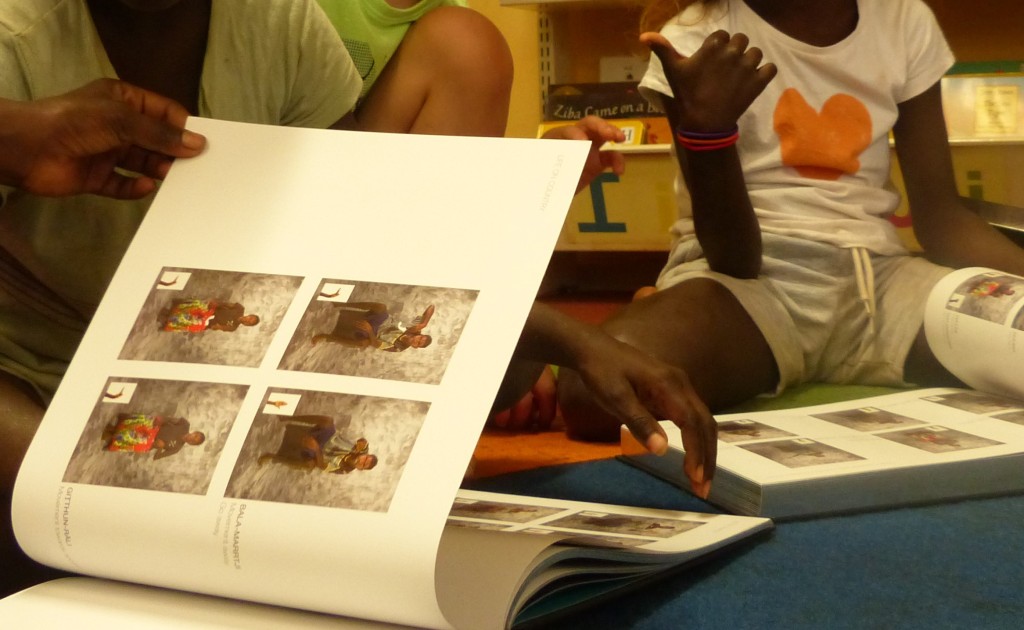
You may see a preview of the signs at the following;
https://signs.yolngusignlanguage.com.au/
Or if you want to purcase a copy or access to the website go to the bottom of the page and click on the HOME button.
Baymarrwaŋa (1917-2014) was a humble and inspirational leader. She lived to celebrate creating a homeland, bilingual school, saving her language, gaining recognition as the ‘Traditional Owner’ over her country, 2012 Senior Australian of the Year and many more rewards in creating the Crocodile Islands Initiative (CII), Crocodile Islands Ranger (CIR) and junior rangers program and a thousand-kilometre Turtle Sanctuary, just for starters. Baymarrwaŋa spent a lifetime promoting the intergenerational transmission of local language and knowledge to sustain authentic livelihoods on the homelands. Her final unfinished project was a book of hand signs.
Baymarrwaŋa would always say “Limalanha gurrku mana maŋutjiguma limalama djäma märr ḏilak yanama dhuyugu Yolŋulu gurruku mana nhäma marŋgiyirri limalagara. Bilabilagumunu ŋanapuluma nhaŋ’kumunu dhäŋuny bulthuna nhapiyana mananha limalama ḏilak miṯṯji nyenanha baman’ŋatjili”. We follow the way of the ancestors, the way of those who come before.[1]
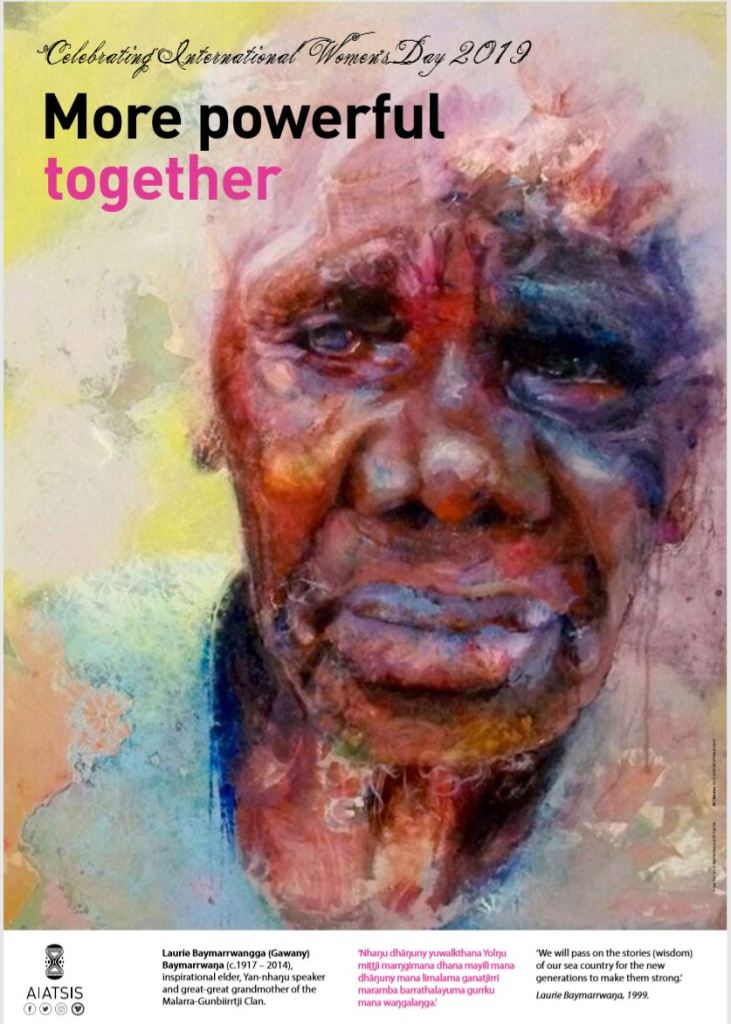
All around Australia indigenous language is extremely endangered. Yolŋu Sign Language (YSL) is an endangered Indigenous Language from North East Arnhem Land. In honour of Baymarrwaŋa’s vision we are shaping an Illustrated Handbook of Yolŋu Sign Language of North East Arnhem Land to give this endangered language back to the children.
Yolŋu Sign Language (YSL) is a unique endangered endemic sign language of the Yolŋu people of North East Arnhem Land. YSL is not a signed version of the locally spoken language. YSL is an alternate language for hearing Yolŋu. It is the primary language of Deaf Yolŋu.[2] YSL has a rich ancestral heritage in dance, ritual and kinship reflecting an intimate relationship with the natural world. In the following we describe something of the project, bimodal-bilingualism, the history of YSL and the motivation for collecting, recording and distributing this unique sign language from across North East Arnhem Land and how to contribute to, and obtain a copy. The Illustrated Handbook of Yolŋu Sign Language of North East Arnhem Land describes the grammar, vocabulary, structure and conventions of YSL in an easy to use and beautiful full colour guide for learning. The Illustrated Handbook of Yolŋu Sign Language of North East Arnhem Land will be distributed, free of charge, to the children of North East Arnhem Land, in honour of Baymarrwaŋa’s vision.

The Illustrated Handbook of Yolŋu Sign Language of North East Arnhem Land presents research from the fields of the ethno-linguistics of alternate sign language and the intergenerational transmission of Indigenous Australian culture. (Kendon (1988) Adone and Maypilama (2014), (2016), Adone et al. (2017)). The work focuses on the endangered Yolŋu Sign Language [3]. Over the last twenty five years we have documented the varieties, use, grammar and principles of YSL with a view to making that research a repository for disappearing signs and available to all. The Illustrated Handbook of Yolŋu Sign Language of North East Arnhem Land will achieve this and more, but it needs support.

2019 WAS the year of ‘Indigenous Languages’. Also, the Australian Institute of Aboriginal and Torres Strait Islander Studies (AIATSIS) celebrated International Woman’s Day in 2019 by recognising Laurie Baymarrwaŋa, the 2012 Senior Australian of the Year, and her vision to ‘give language back to the children’. With her vision at its heart, The Illustrated Handbook of Yolŋu Sign Language of North East Arnhem Land documents, explains, illustrates and teaches the vocabulary, alphabet and grammar of YSL, with captions and text in Yolŋu and in English. The growing popularity of spoken Yolŋu will improve the prospects for this barely known and increasingly endangered language. The book honours the vision of Laurie Baymarrwaŋa and gives opportunities for all to be part of, and contribute to, the aims and aspirations of this profound work. This project, if supported effectively, will ensure the future of YSL.
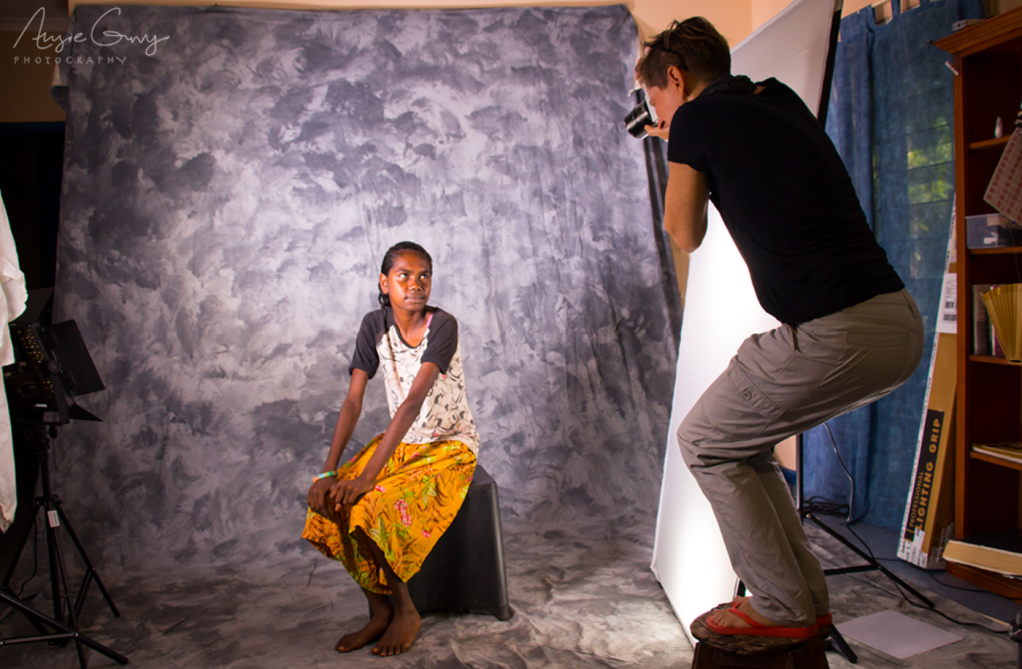
YSL, once known as Murngin Sign Language, is an endemic sign language of the Yolŋu community of North East Arnhem Land.[4] As previously emphasised YSL is not a signed version of any spoken Yolŋu language but an alternate language of sign for hearing Yolŋu people, and a primary language for the Deaf (Adone 2016) YSL, having evolved to communicate and respond to the unique and complex ritual and religious life of the Yolŋu people, reflects their intimate relationship with an ancestral geography and kin based universal view. (Morphy 2008). Distinctive characteristics entailed in an absolute Frame of Reference for spatial expression and powerfully developed schema of signed kinship relationships (Levinson 1996a). YSL is used during periods of mourning when speech is culturally forbidden. It is also used in the presence of sacred objects and sacred sites, during ceremony and in the company of poison kin. YSL is also used for practical reasons, such as communication over distance, secrecy or for silent hunting practice. In the past YSL was learned from birth along with spoken language but its intergenerational transmission has been severely diminished by changes imposed (both deliberately and coincidentally) by the Settler State.

Anthropologist Lloyd W Warner collected the first seventy signs of YSL on the Crocodile Islands while visiting there during the period of 1926-9. Those signs, bar a few changes, are still in use today. Warner, like Vogelin et al. (1963:25) noted a widespread “culture of multilingualism”, but had not yet recognised the multilingual bimodalism of alternate sign languages. The field of Sign Linguistics defines ‘bimodal-bilingualism’ as the ability to use both spoken and signed languages to communicate. Bimodal-bilingualism is common practice in Australian Indigenous societies. In these societies the hearing population often use several spoken languages (auditory modality) and are also fluent in an Indigenous sign language (visual modality). (Kendon (1988) Adone and Maypilama (2014), (2016), Adone et al. (2017)) Common bimodal-bilingualism, with the exception of Native American communities, is rare elsewhere in the world (Farnell 1995, 2003). Bimodal-bilingualism is an aide to communications among geographically and linguistically distant groups. (Adone et al. 2017)
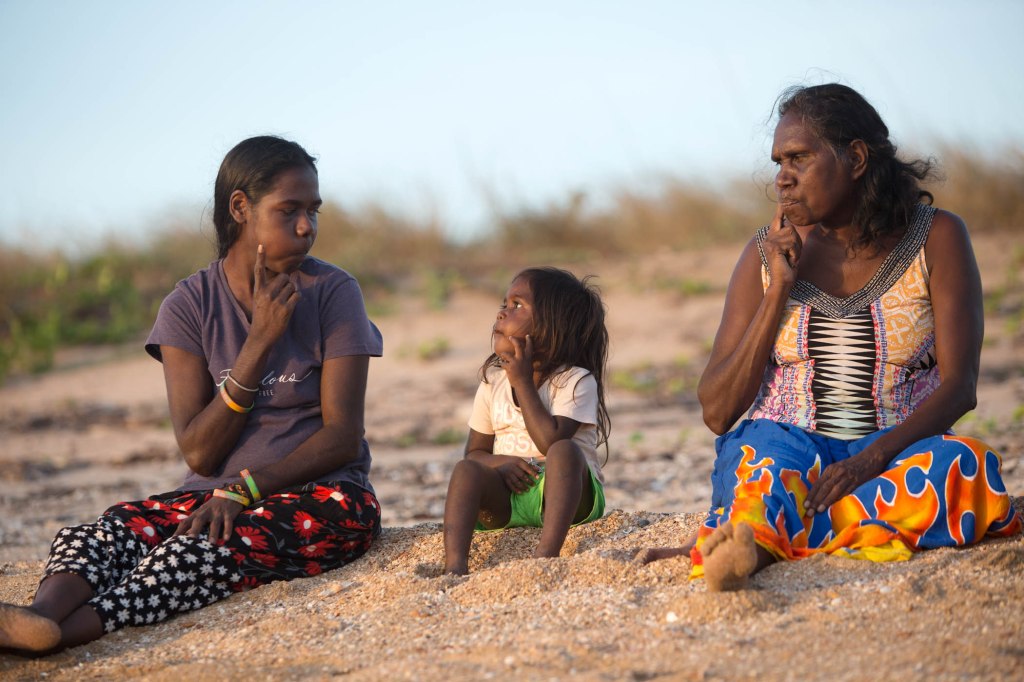
It is not clear how bimodal-bilingualism on the Australian continent came to be so ubiquitous, perhaps it was born of the continuity of countless generations in place, and its changing of environment over eons. Aridification, uncertain ecological carrying capacity and subsistence economies promoted long distance networks of ritual, marital (connubial) and economic relations, thus stimulating multilingualism and bimodal-bilingualism across geographically distant groups speaking different languages.[5] Ethnographic and linguistic evidence from the languages of Arnhem Land describe profound linkages between the Yolŋu experience of connection to place and each other as kin. It is this singular kin-based universal view and linked ancestral geography that anchor Yolŋu society to sites in place. The deep connections of place, of sites, songs and kin, in physical and social space, form a network of relations that anchor kin to country, evident in Yolŋu languages and YSL. The Illustrated Handbook of Yolŋu Sign Language of North East Arnhem Land records in vibrant colour the bimodal metaphors, idioms and signs of the Yolŋu experience of kin and country.
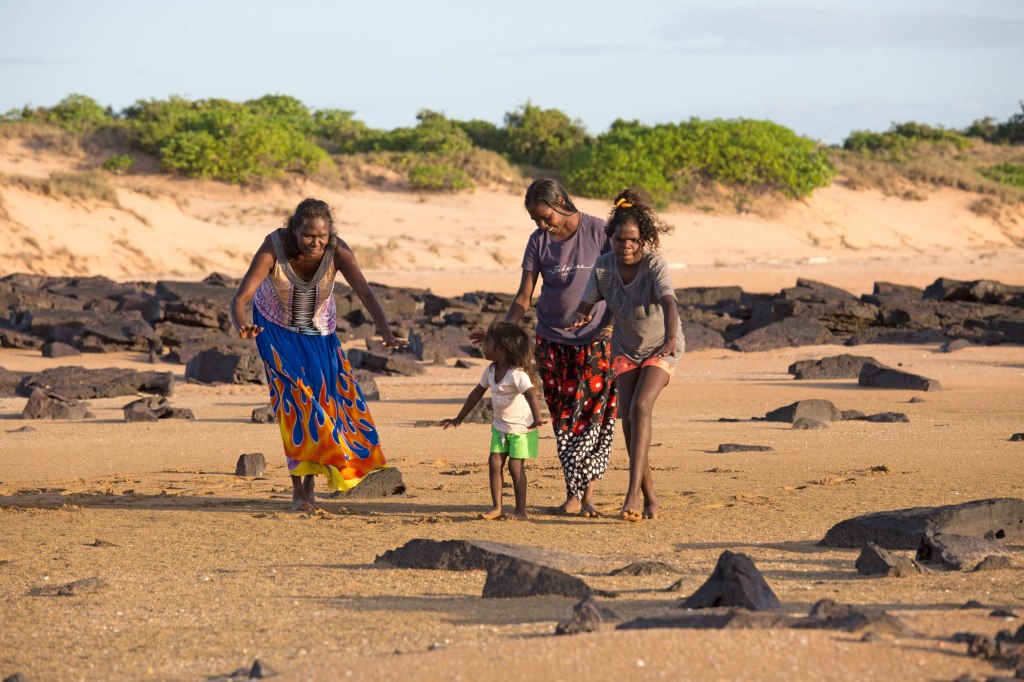
The accelerating loss of YSL motivated us to conduct this vital research and produce this beautiful handbook. We are a team of Yolŋu and non-Yolŋu people committed to record, retain and pass on this ancestral Inheritance of our languages and links to country. We are brothers and sisters in our commitment to this language. We do it for the children and for the future of Yolŋu society and the broader society that will be impoverished if YSL is allowed to die out. We continue to tell the story of how we were given these gifts by the ancestors and how we continue, despite official indifference, to care for and replenish our rare languages and our history. The following is an expression of the aims of this project from a Yolŋu perspective and is translated into English below.
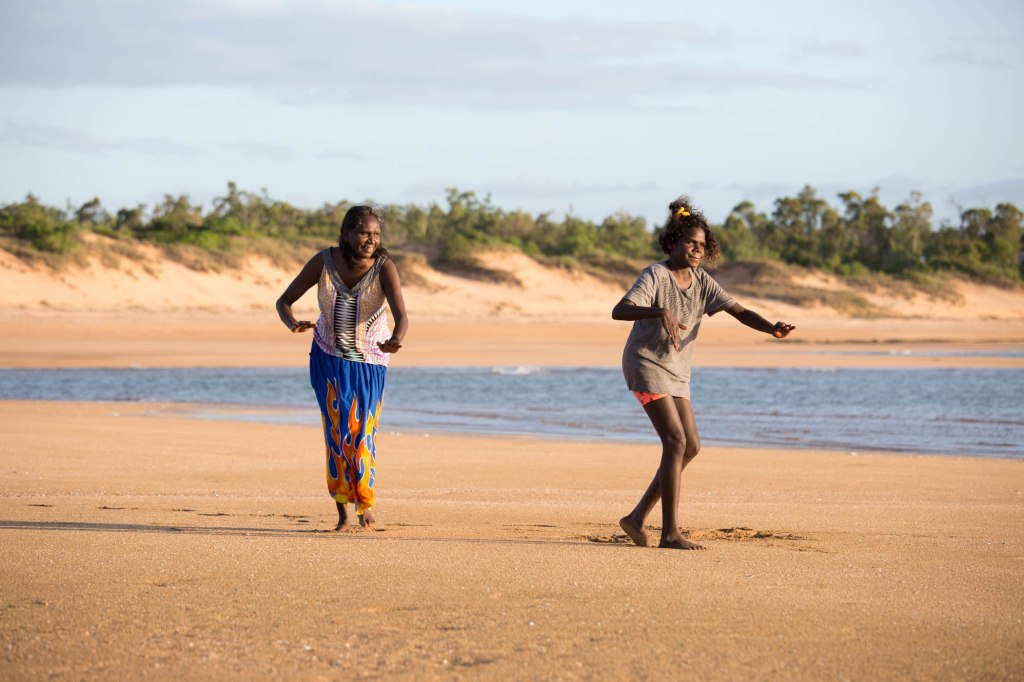
Yolŋu’-Yulŋuy ŋuli ga ḻakaram dhäwu goŋdhu
Rumbal-yu dhäruk, dhuwandja djorra’ Yolŋuw ga Yolŋu yan, yuṯaw djämarrkuḻiw’yalalaŋumirriw. Djämany napurr balandawal mala dhuŋgarra ŋupan ga märryu ḏapmaram Djalkiri Rom, ga nhämunha wäŋa limurruŋ riŋgitjkurr. Ŋuruŋi yolŋuy wala gan nhäŋal ga ŋäkul nhaltjarr gan ŋaḻapaḻmirr limurruŋ nhinan baman’. Limurr dhu dhärra ga mel-gurrupan limurruŋguwuy djäma märr walal dhu yuṯay Yolŋuy nhäma ga marŋgithirr limurruŋgal. Ga balanyamirriy napurr ŋunhi dhäwuny lakaram nhaltjarr gan limurruŋ ŋaḻapaḻmirr nhinan baman’birr, napurr yuṯakum dhuwal dhäwumirr djorra’marŋgikunharaw yuṯaw Yolŋuny. Napurr Yolŋuy dhu marŋgikum yuṯany Yolŋuny ga dhärray walalaŋ ga marŋgikum yan yuwalkkum Djalkirriw Romgu walalany.
Nhä dhäwu ga lakaram dhiyal djorra’ŋur ga nhäpuy?
Dhiyal djorra’ŋur ga lakaram dhärukpuy ga nhatha ŋuli limurr bäki. Yuṯa Yolŋu dhu marrtji ŋuthan ga marŋgithirr nhaltjan dhu dhäruk bäki rumbal-yu yan ga balanyakurr marŋgithirr waŋanharaw nhaltjan napurr dhu waŋa goŋ’dhu yan. Ŋurukaliyi ŋunhi ŋayi buthurumiriw ga dhärukmiriw yolŋu, wiripuŋuy yolŋuy mala ŋuli bäki dhäruk rumbal-yu ga goŋ’dhu. Napurruŋ ga ŋorra’ barrkuwatj yäku mala nhakun dhäruk-miriw ga dhoŋulu, yan rumbal-yu ga goŋ’dhu napurr dhu dhäruk dhawaṯmaram walalaŋgal.
Dhäruk napurr ŋuli wiripuny dhawaṯmaram buŋgulkurr goŋ’dhu ga rumbal-yu napurruyingal rrambaŋi yan Djalkarikurr Romgurr, dhuwalatjan napurr ŋuli ŋamaŋamayun napurruŋguwuy ŋaḻapaḻmirriny. Waŋanhamirr wiripuny napurr ŋuli rumbal-yu ga goŋ’dhu ŋunhi napurr ŋuli nhina ga muŋa-muŋany yan, bawalamirrŋur, balanya nhakun wakir’ŋur, buŋgulŋur wo wakalmirri’ŋur. Dhärranayŋu nhininyŋu dhuwal rom napurruŋ. Napurr wäŋa nhininyŋuy ŋuli ga nhäma, wäŋa ga marŋgi nhaltjan napurr ga nhina rakikurr ŋunhi ga ŋayatham wäŋay ŋarakay, märr dhu djämarrkuḻi’marŋgithirr dhiyaŋ dhäwuy.
Bili dharrwa ga mulkuru rom marrtji yuṯay yolŋuy ga bäyŋu dharaŋan baḏuwaḏuyunamirr rom. Napurruny ga wiripunywuy yup’maram ŋunhi wanhaŋuwuy napurr yuwalk, balanya nhakun napurruŋgiyingalaŋaŋur yirralkaŋur mala, bäyŋu dhukarr ga ŋorra nhakun nhinanharaw ŋaḻapaḻmirriwal ga buluŋuw marŋgithinyaraw Djalkiriw Romgu ŋamaŋamayunaraw. Dhumukthirra marrtji romdja balandany marrtji ŋurruthirra romdja marrtji ḏälthirra. Mulkuruynha romdhu ga nhina dhiyaŋuny bala balanya nhakun mobile-yu ga TV-nha. Ŋunhi baydhi limurr dhu ga nhina dhiyaŋ romdhu ga yaka yan limurr dhu moma limurruŋguwuy Djalkari Romdja dhuwaliyi mala ŋunhi gämurruny napurr nhina ga ŋamaŋamayundja dhuwal dhäwumirr djorra’ yuṯaw yolŋuw yalalaŋgumirriw.
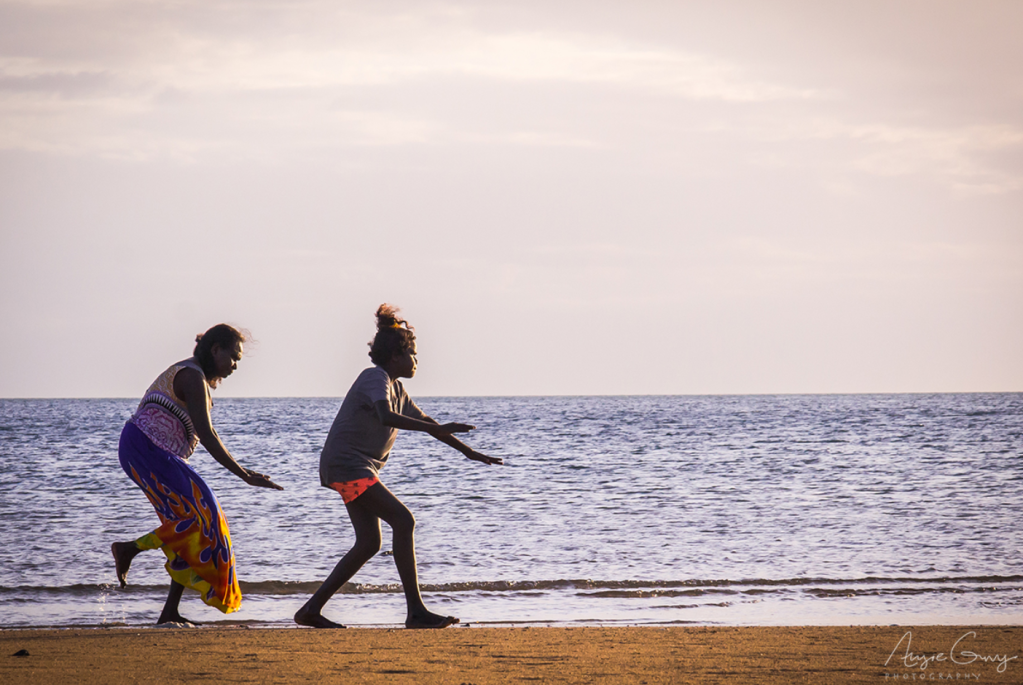
English translation.
We are working hard to keep the precious knowledge about our world fresh and pass it on to a new generation following in the footsteps of our ancestors. Many great people have come in front to show us how to live and pass on this important knowledge. We must continue to show the way for those who come behind. We are the people who are the guardians of the land and the knowledge for the new generations.
What this book is for and about?
This book is about the language we Yolŋu use to communicate with each other when we don’t want to speak. Before, every Yolŋu child would grow up learning sign language as they learn to speak their language. We learn to speak and sign. People who can’t hear and people who can all use this language. We have a number of names for this alternate language of signs. We call it ḻakaram goŋdhu
Here is a language we use in dance, in ceremonies celebrating the ancestors. We follow their actions and movements, we mimic the way that they created the world we live in. We perform the characteristics of the ancestors in signs that celebrate their gifts to us in the form of the world, language, in the way we live our lives.
This is a way of talking when silence is needed, in hunting, in ceremony, for fun. It is a natural part of life. We people of the land have signs that we read, talk, know and understand that show our connection to each other, to our country, it is part of our heritage. It is something we want the children to know.
This language is endangered for many reasons that stem from the coming of the colonists. The routines of community life are diminishing opportunities to visit and reside on homelands, opportunities to travel to and participate in ceremonies, less time spent with elders, and western styles of teaching, curriculum and changing technologies and attitudes have left less space for our sign language to be used. The television and recent small screen phenomena have also changed the way we see ourselves and communicate. Even though these things are changing it is still important to care for our ancestral heritage.
End of translation.
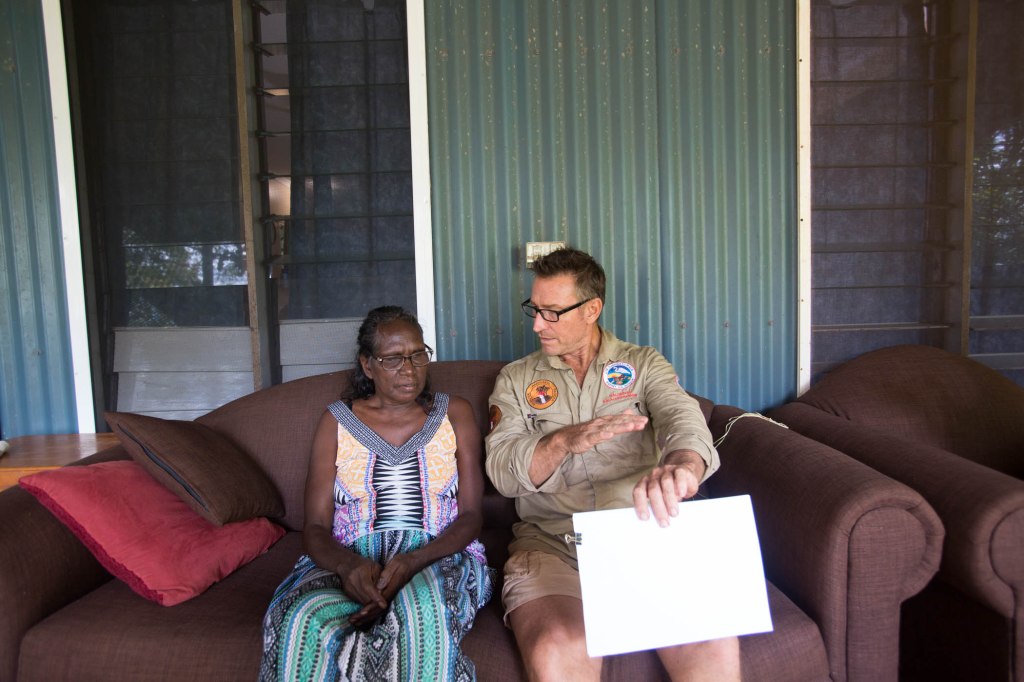
After the success of distributing the Yan-nhaŋu Atlas and Illustrated Dictionary of the Crocodile Islands for the kids of North East Arnhem Land demonstrates the practical value of this strategy was apparent. The Illustrated Handbook of Yolŋu Sign Language of North East Arnhem Land, was funded in part by the people who purchased the ATLAS.
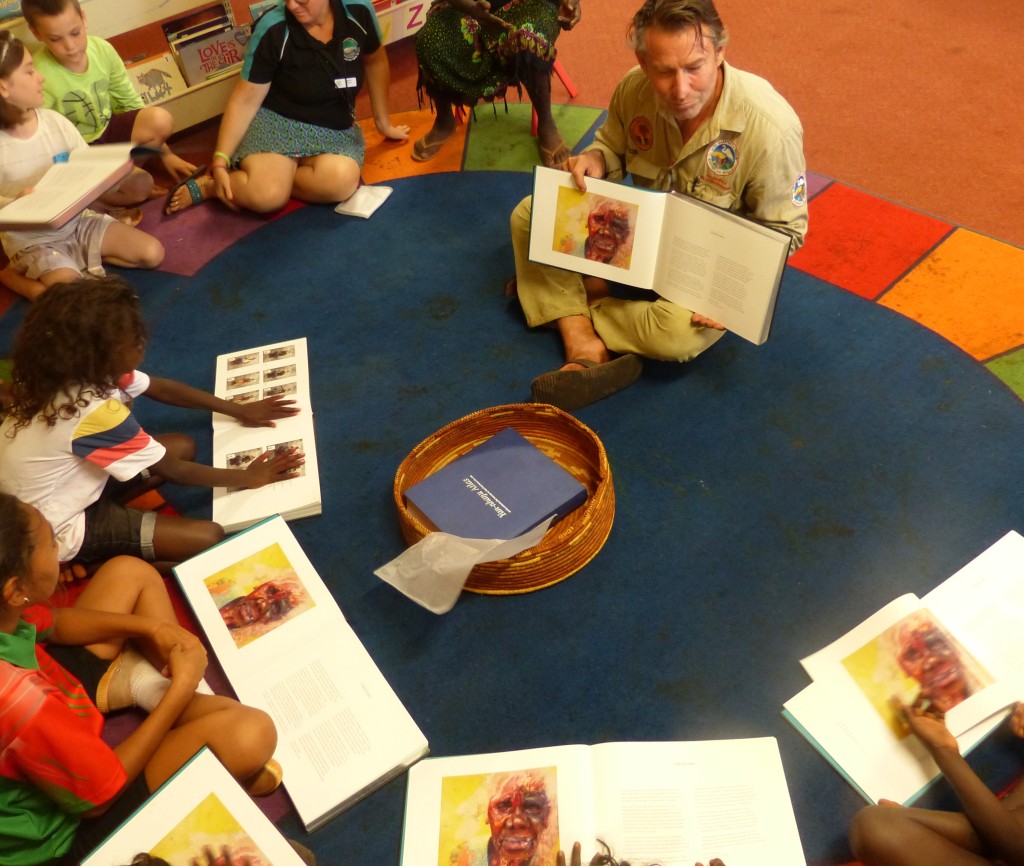
We need your support to bring over five hundred signs of YSL collected from across North East Arnhem Land together in an exceptional and substantial volume, AND to fund our next project..
Help us honour Baymarrwaŋa’s vision to save this Indigenous language and give back to the children.

NOW IS YOUR CHANCE TO HELP
click on home and purchase a copy
E-mail: bentley.james.dr@gmail.com
Mobile: 0402704354
Bibliography.
Adone, M.C.D. (2014)“Research Report: Indigenous Sign Languages of Arnhem Land.” Australian Aboriginal Studies (AIATSIS), vol. 1, , pp. 132-136.
Adone, M.C.D., & Maypilama, E.L. (2015). The Sociolinguistics of Alternate Sign Languages of Arnhem Land. Learning Communities: International Journal of Learning in Social Contexts [Special Issue: Indigenous Sign Languages], 16, 14-25. doi: 10.18793/LCJ2015.16.02.
—- (2014a).A Grammar Sketch of Yolŋu Sign Language. München: LINCOM.
— (2014b) “Research Report: Bimodal Bilingualism in Arnhem Land.” Australian Aboriginal Studies (AIATSIS), vol. 2, 2014, pp. 101-106.
Adone, M.C.D., Elaine L. Maypilama, B. James and Melanie A. Brück. Anchoredness in Nature and Environment: Linguistic Evidence from Indigenous Australia. Paper presented at the Centre for Australian Studies Universität zu Köln (Cologne) 1.3.2015
—- in press, (2018a) Yan-nhangu Language of the Crocodile Islands: Anchoredness, Locatedness and Connectedness. Centre for Australian Studies Universität zu Köln (Cologne).
—- in press, (2018b) A Signed Lingua Franca in Arnhem Land. Centre for Australian Studies Universität zu Köln (Cologne).
—- in press, (2017a) Indigenous Languages of Arnhem Land in Key Concepts in Indigenous Studies Routledge Press, Series editors G. N. Devy and Geoffrey V Davis.
Baymarrwaŋa, L, James, B (2017). ‘Voice of the Land: Laurie Baymarrwaŋa in Aigner, K (editor), 2017. Australia: the Vatican Museums collection. CittaÌ del Vaticano : Edizioni Musei Vaticani.
—- (2014) Yan-nhaŋu Atlas and Illustrated Dictionary of the Crocodile Islands. pp.576. The Tien-Wah press, Singapore & Sydney Australia.
Baymarrwaŋa, L. James, B. and Lydon, J. (2014), ‘The Myalls’ Ultimatum’: Photography and the Yolngu in Eastern Arnhem Land, 1917 in J. Lydon (ed) Calling the Shots: Aboriginal Photographies, (Canberra, ACT: Aboriginal Studies Press)
James, B., (2019) Fish Traps of the Crocodile Islands: Windows on another World in At Home on the Waves: Human Habitation of the Sea from the Mesolithic to Today eds Tanya J. King & Gary Robinson, Berghahn Books New York-Oxford.
—- (2015) The Language of Spiritual Power: From Mana to Märr on the Crocodile Islands. In Strings of Connectedness: Essays in Honour of Ian Keen (Ed Toner P.G.).pp.235-263. ANU Press Canberra.
Kendon, A., (1988) Sign Languages of Aboriginal Australia. Cambridge UP.
Levinson, S. C. and D. P. Wilkins (eds.) 2006. Grammars of Space: Explorations in Cognitive Diversity. Cambridge: Cambridge University Press.
Maypilama, E.L., (2012) Cross- Modal Contact in Shared-Signing communities: Kinship. Paper accepted but not presented for the EuroBABEL final Conference hosted by the European Science Foundation, Leiden, The Netherlands, 23-26 August.
Maypilama, E.L., &Adone, D. (2013). Yolŋu Sign Language: An undocumented language of Arnhem Land. Learning Communities: International Journal of Learning in Social Contexts, 13, 37-44. doi: 10.18793/LCJ2013.13.05.
—- (2012a) Non-Manual Features in an Alternate Sign Language. Invited paper presented at the National Institute for Deaf Studies and Sign Language. La Trobe University, Melbourne, Australia. July, 2012.
—- (2012b) Yolngu Sign Language an Alternate Sign Language? Invited paper presented at TELC meeting, Charles Darwin University, Darwin. Australia. August 2012.
—- (2012c) Language Mixing between a spoken and signed language: A Case Study of bimodal bilingualism. Paper presented at the Workshop on Language Contact. University of Aarhus. Denmark April 11-13th April 2012.
Morphy, F., (2008) Invisible to the state: Kinship and the Yolngu moral order. Centre for Aboriginal Economic Policy Research (CAEPR) seminar series, Wednesday, 29 October 2008. ANU. Canberra.
Warner. L. W., (1937), A Black Civilization: A Social Study of an Australian Tribe. Harper and Brothers Publishers. London, UK.
—-1978 Murngin Sign Language in Aboriginal Sign Languages of the Americas and Australia volume 2 eds, D. Jean Umiker-Sebeok and Thomas A. Sebeok. Indiana University Bloomington. Plenum Press New York and London.
The authors would like to thank,
Ferg Ferguson, Glenn James, Janely Seah, Maria Manno, Tony Philips and Doris Burarrwaŋa
This collaboration between Elaine Maypilama, Marie Carla Dany Adone and Bentley James began in 1994 when the three met at Galiwin’ku, and proposed to write a book on YSL. The Illustrated Handbook of Yolŋu Sign Language of North East Arnhem Land is encouraged by sustained Yolŋu support and has continued to collaborate with Yolŋu elders from Blue Mud Bay in the east to the sunset west of Milingimbi in the Crocodile Islands, to document, share, inform and entertain through YSL.[6]
[1] Posthumous award of the United Nations Peace Prize for Indigenous Film. 2015. ‘Big Boss Last Leader of the Crocodile Islands: Buŋgawa bathala rom ḏäl ga rälpa ḏumurru’. Year: 2015. NITV; Runtime: 53 min, Directed By: Paul Sinclair, Produced By: Jade Sinclair Matt Dwyer, Language: Yan-nhangu language, English subtitles
[2] The word deaf is conventionally written with a capital D when it is used as a cultural label especially from within the culture and identity of sign language users.
[3] YSL is also designated Glottolog yoln1234, ISO 639-3 ‘ygs’ (inclusive)and the Individual code for Yan-nhaŋu Sign Language is: ‘yhs’.
[4] The name ‘Murngin Sign Language’is an anachronism from the 1920s coined by the famous American Professor of Anthropology and author of A Black Civilisation: Social Study of an Australian Tribe (1937) Lloyd W Warner.
[5] More broadly this geographic separation and multilingualism might explain why a bimodal-bilingual hearing population of Indigenous groups in many parts of Australia used sign languages as an improvised lingua-franca. (Adone et al)
[6] YSL and yhs data is verified by senior Yolŋu and has been annotated using digital video annotation software called ELAN (Eudico Linguistic Annotator). Further data was processed using the dictionary building tool Lexique Pro developed by SIL International. Further data is stored in video and photographic files with the Yan-nhaŋu Dictionary Team.
Desinged, Photogaphed with ‘Magic’ by Therese Ritchie.
Designed by Therese Ritchie. Photographs of signs © Therese Ritchie.
Hand photography © David Hancock/Skyscans.
© David Hancock/Skyscans
© Therese Ritchie.
For permission to use the images contact us.
The Illustrated Handbook of Yolŋu Sign Language of North East Arnhem Land
I hope this finds you well and trust it will bring you joy in these interesting times. (Sen.) Pat Dodson reminds us; ‘As with First Nations peoples elsewhere, Yolŋu people are struggling to keep hold of their culture, laws and languages. This book serves to remind us all that we must share in the struggle to make space for Indigenous languages and culture as part of the collective gift of our priceless cultural inheritance.’ Some of you are cut from this stone.
I would like at this time to present to you the story of one of the volunteers on our wonderful project, Angi Gray, and her journey from Sweden to Elcho Island. Before I do, let me thank again all those wonderful people that helped get this project up and running. If you missed the opportunity to assist or donate during the production stage, some books may be left over to buy. Do not try donate now, details pending.
To those who are involved, wow, outstanding, but wait until you see what I mean. Wait till you see the book and website. OMB. Your book is coming to you now so check your mail. Please enjoy this story from Angi about her journey to help save YSL with us.
The volunteer project on Galiwin’ku
It was hard to imagine what was awaiting as I got on the night train that would take me away from the snow-covered Swedish landscape on the fourteenth of March 2018. Suddenly I found myself there, three months later, in biting sun and dusty red soil among some of the world’s most untouched landscapes. I had been given the opportunity of participating in a volunteer project aimed on documenting an extremely endangered sign language called Yolngu Sign Language (YSL) on an island off the north-east coast of Australia, today populated by some of the largest and most remote Aboriginal communities in the Northern Territory region. This invitation came from one of the project’s photographers Therese Ritchie, who was a good friend of my father before he moved from Australia thirty years ago.

Good to know:
• The island’s original name is Galiwin’ku, but it is also known under the European name
Elcho Island.
• Today, about two thousand people live on the island.
• Ninety-nine percent of the population are Yolngu, which is a collective name for
Australia’s indigenous people living in the northeastern parts of Arnhem Land.
• Eight different languages and twenty-two dialects are used on Galiwin’ku.
• All languages spoken on the island are part of the language group Yolngu-matha, which
translates into “human tongue.”
• Galiwin’ku has been under colonial rule as long as the rest of Australia, however, the
island’s isolated location and lack of natural resources have resulted in it remaining
relatively untouched by western influences in comparison to other parts of the country.
On Friday the twenty-fifth of May I stepped out of Galiwinku’s Airport with Therese and David Hancock, both of whom had been photographers during a similar project on the island about twenty years ago. Well outside we were met by a tall man wearing an emblem-covered shirt, introducing himself as Dr. Bentley James: anthropologist and linguist. Next to him stood an elderly Aboriginal woman who looked from him to us, and then started a conversation in a language I did not understand. Dr. James started talking to her and she nodded after a while as to show that she had accepted us.
Shortly after that we sat in Dr. James’ car and he drove us over swirling dust, pointed at one of the valleys and spontaneously began to tell us the ancient story of how this came to be according to the Yolngu people’s faith. Still unaware of what my role would be during the project, I could only pull out my camera in an attempt to capture the intense drive. Dr. James told us that he has worked side by side with Yolngu people for twenty-five years and knows two of the local languages: Dhuwal and Yan-nhangu.

After just a few minutes we arrived at the little house that would be our home for the next seven days. When I was about to take my shoes off in the combined kitchen and living room, I heard Dr. James say: “I’d keep them on if I were you. The floors are covered in dog shit.” The smell of raw fish was thick and he excitedly revealed that our dinner would be the latest catch he had caught with a traditional fishing line called raki. We ate dinner out on the veranda, accompanied by chanting and singing echoing in the distance – a funeral ceremony, Dr. James explained.
Later that evening my task was revealed: to film the signs which the Yolngu people on the island would demonstrate to us, with the goal of creating material for an app that new generations of Yolngu can use. Therese would photograph each character while Dr. James translated them from Yolngu-matha into English. Therese will then design a book which will be donated to the island’s school, Sheperdson College, and to various libraries around Australia, with the purpose of enabling future generations of Yolngu to learn and use YSL.

In Dr. James’ living room we built a small studio in which the air was loaded with enthusiasm, curiosity and appreciation. On the third day we met our first volunteer: the Yolngu-woman Doris Yethun, who has worked with Dr. James through various projects over the span of twenty years.
Other volunteers that joined us were Michael, Daisy, Fred and Shannelle. When we weren’t documenting we sat out on the veranda, drank (huge amounts of) tea and shared our lives with each other. I’ve come to know people whose lives are the direct opposite of mine, but who I came to connect with through the universal, human language. Michael was completely deaf but always filled the room with heartfelt laughter through to the humor and dynamics he had when signing.

I also got to know the exceptional life story of Doris Yethun. She told me that she was born in the mangroves on an island far from Galiwin’ku and that her parents wrapped her in paperbark to keep her warm at night. A few years later, Doris and her family travelled to Galiwin’ku by canoe – including her father’s seven wives and her twelve siblings. On the island she married the man she’d been promised to by her parents and they now have three children.
Today, Doris works as a teacher and for the Strong Women’s Association on the island. She also does volunteer work for the Family Violence Group. Doris’ passion is to teach the children on the island about their culture, language and traditions. A quote from her is: “What is most important are the stories of the country. (…) It is a network of links to our ancestors and their stories and their creations that make us all one people.”

During that week, it became clear to me what an essential connection the signs have to the life and world view of the Yolngu people. The signs spoke about the animals and the seasons, about hunting and marriage, about life and death. We also documented a series of idioms – characters that show one thing to symbolise something else. Newer words such as iPad, computer and Facebook were also included. What makes YSL so unique is that it’s also used as an alternative mode of communication in situations where it is not appropriate to speak, for example, when on holy land or when performing certain rituals. Therefore, YSL is not only a sign language but also an alternative communication method used in the rites and traditions of the Yolngu people.

At the turn of the century, the Australian government began to invest less in bilingual education in the Northern Territory, which made it more difficult for new generations of Yolngu to maintain their native languages as well as their traditional sign languages. For example, a law was introduced in 2009 where school children were only allowed to speak English during the first four hours of school each day in the Northern Territory, where most of Australia’s indigenous population live. In addition, nine municipal schools and a number of private schools began to teach only through English. A national study called the National Assessment Program (NAPLAN) from the following year showed that literacy fell dramatically in several of these schools, which indicates that the students performed better when they were taught through their native tongues first, and then through English.
To enable future generations of Yolngu to share their ancestor’s languages and traditions, the Learning on Country project has been established on Galiwin’ku. Today, the project is run by Dr. James and Doris Yethun among other knowledge-keepers on the island. I got to participate in one of the learning opportunities when a school class was taken to an incredible rock beach to learn about building traditional fish traps – a technique that has been around for at least five thousand years. In addition, the children were taught different words connected to the building process as well as its spiritual significance. The construction of the fish traps is an example of an activity where one should not speak – this is not to upset the good spirits at the place which can help the hunter to attract the fish.

In addition to the fish traps, the children have learned about the essential ties that their ancestors have to different places on the island. Something that surprised me was just how important the names were for the different places and how all of them are linked to a specific creation story, which could be incredibly complex. According to the Yolngu people’s faith, Dr. James explained, the stories of the spirits and songs have created the world. These spirits continue to coexist with us so that the world is treated with respect and in harmony with the traditions. In short, the Yolngu people believe that each place, human and language are linked to each other in a kin-based social universe. Additionally, I learned that each language has a unique way of explaining each of
these places. In this way, the languages are the key to Yolngu’s worldview and spirituality.


Thus, a language is not just a way of communicating – it’s part of our identity and is deeply rooted in our world view. Whether it is a spoken or signed language, they carry on an ancient connection and understanding between people. If a language disappears, so will the knowledge and the essential ties passed through it. Some of the last words that Doris Yethun said to me were, “Do not forget us. And we will not forget you.” I’ll never forget the people at Galiwin’ku, even if their struggle continues on the other side of the world. This trip made me realise more clearly than ever that we are all human beings. If a culture disappears for someone, it disappears for all of us.
– Angie Gray, 21.07.2018
Sources:
Dr. Bentley James. 2018. URL: https://drbentleyjames.wordpress.com
Mark Schliebs, The Australian. Published at 12:00 AM on November 16, 2010.
URL: https://
http://www.theaustralian.com.au/news/nation/four-hours-of-english-policy-hitting-test-results/news-story/
04af0770f5199cf49dcda4e3d19df024?sv=6d7e356e8f7ebb8a68d2187399490094
The Arnhem Land Progress Aboriginal Corporation. 2018.
URL: https://www.alpa.asn.au/galiwinku/